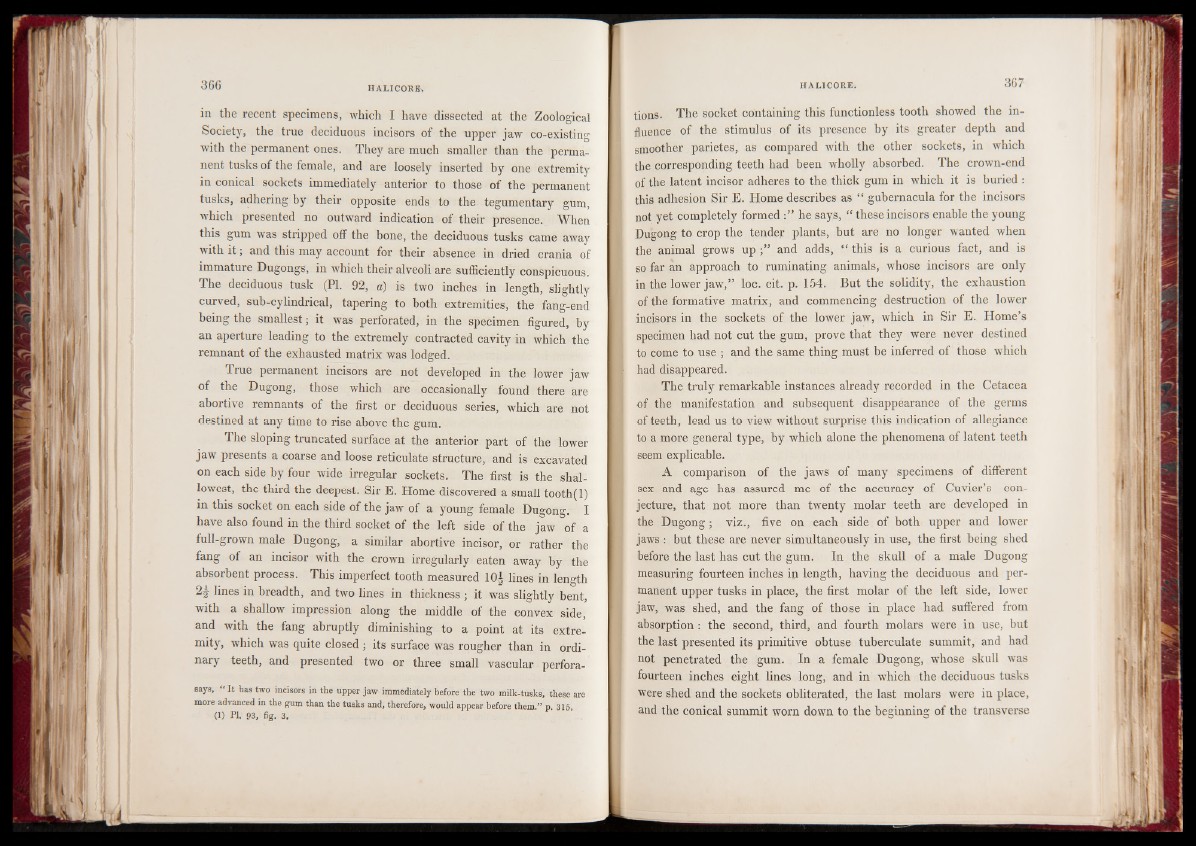
in the recent specimens, which I have dissected at the Zoological
Society, the true deciduous incisors of the upper jaw co-existing
with the permanent ones. They are much smaller than the permanent
tusks of the female, and are loosely inserted by one extremity
in conical sockets immediately anterior to those of the permanent
tusks, adhering by their opposite ends to the tegumentary gum,
which presented no outward indication of their presence. When
this gum was stripped off the bone, the deciduous tusks came away
with it ; and this may account for their absence in dried crania of
immature Dugongs, in which their alveoli are sufficiently conspicuous.
The deciduous tusk (PI. 92, a) is two inches in length, slightly
curved, sub-cylindrical, tapering to both extremities, the fang-end
being the smallest; it was perforated, in the specimen figured, by
an aperture leading to the extremely contracted cavity in which the
remnant of the exhausted matrix was lodged.
True permanent incisors are not developed in the lower jaw
of the Dugong, those which are occasionally found there are
abortive remnants of the first or deciduous series, which are not
destined at any time to rise above the gum.
The sloping truncated surface at the anterior part of the lower
jaw presents a coarse and loose reticulate structure, and is excavated
on each side by four wide irregular sockets. The first is the shallowest,
the third the deepest. Sir E. Home discovered a small tooth(l)
in this socket on each side of the jaw of a young female Dugong: I
have also found in the third socket of the left side of the jaw of a
full-grown male Dugong, a similar abortive incisor, or rather the
fang of an incisor with the crown irregularly eaten away by the
absorbent process. This imperfect tooth measured 10| lines in length
2t% lines in breadth, and two lines in thickness ; it was slightly bent,
with a shallow impression along the middle of the convex side,
and with the fang abruptly diminishing to a point at its extremity,
which was quite closed ; its surface was rougher than in ordinary
teeth, and presented two or three small vascular perforasays,
“ It has two incisors in the upper jaw immediately before the two milk-tusks, these are
more advanced in the gum than the tusks and, therefore, would appear before them.” p. 315.
(1) PL 93, fig. 3.
tions. The socket containing this functionless tooth showed the influence
of the stimulus of its presence by its greater depth and
smoother parietes, as compared with the other sockets, in which
the corresponding teeth had been wholly absorbed. The crown-end
of the latent incisor adheres to the thick gum in which it is buried :
this adhesion Sir E. Home describes as “ gubernacula for the incisors
not yet completely formed he says, “ these incisors enable the young
Dugong to crop the tender plants, but are no longer wanted when
the animal grows up and adds, “ this is a curious fact, and is
so far an approach to ruminating animals, whose incisors are only
in the lower jaw,” loc. cit. p. 154. But the solidity, the exhaustion
of the formative matrix, and commencing destruction of the lower
incisors in the sockets of the lower jaw, which in Sir E. Home’s
specimen had not cut the gum, prove that they were never destined
to come to use ; and the same thing must be inferred of those which
had disappeared.
The truly remarkable instances already recorded in the Cetacea
of the manifestation and subsequent disappearance of the germs
of teeth, lead us to view without surprise this indication of allegiance
to a more general type, by which alone the phenomena of latent teeth
seem explicable.
A comparison of the jaws of many specimens of different
sex and age has assured me of the accuracy of Cuvier’s conjecture,
that not more than twenty molar teeth are developed in
the Dugong; viz., five on each side of both upper and lower
jaws : but these are never simultaneously in use, the first being shed
before the last has cut the gum. In the skull of a male Dugong
measuring fourteen inches in length, having the deciduous and permanent
upper tusks in place, the first molar of the left side, lower
jaw, was shed, and the fang of those in place had suffered from
absorption : the second, third, and fourth molars were in use, but
the last presented its primitive obtuse tuberculate summit, and had
not penetrated the gum. In a female Dugong, whose skull was
fourteen inches eight lines long, and in which the deciduous tusks
were shed and the sockets obliterated, the last molars were in place,
and the conical summit worn down to the beginning of the transverse